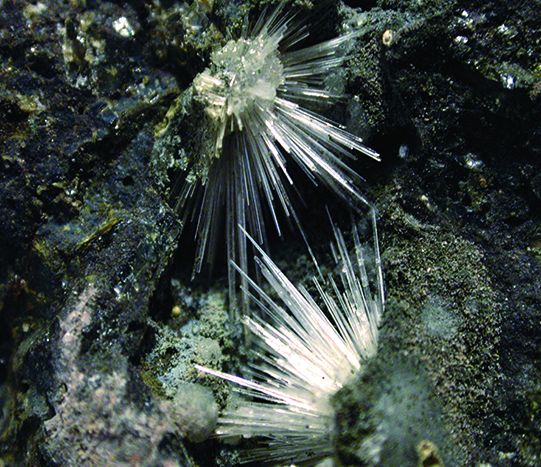
Expanding on a Hypotheses About Amygdale Pseudomorphs
By Steve Ewens
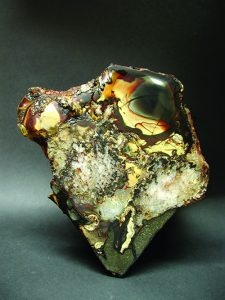
Publication of “Hart Mountain Hypotheses” in the April 2018 issue of Rock & Gem was an initial attempt at explaining the cause and origin of amygdaloidal specimens found on Hart Mountain. As time has passed and I’ve spent more time exploring and learning, I’ve expanded on my hypotheses some.
Hart Mountain is in remote southeastern Oregon near the small town of Plush. Rising sharply from the relatively level sagebrush flats, Hart Mountain soars to an elevation of 8,017 feet with a prominence of approximately 3,600 feet. Hart Mountain is a block fault mountain whose birth in the early to middle Miocene Era was accompanied by extensive lava flows and seismic activity. Currently, the area is home to Hart Mountain National Antelope Refuge, which encompasses over 422 square miles.
This region is the area of focus for my 15-year study of amygdaloidal formation and origin. The study area encompasses approximately 20 square miles of rugged terrain located on the northwest face of the mountain and consists of five site-specific study locations. Interestingly, amygdales from each study area tend to have unique attributes despite some overlap. For those unfamiliar with the term amygdale (also spelled amygdule), the term originates from the Greek and means almond-shaped. This definition is an apt description as nearly all of the specimens in my collection exhibit this trait in readily observable habit. However, in some cases, amygdale specimens in the collection are incomplete sections or portions of larger amygdales. Some of these were quite large. While the original shape is not readily apparent, the original amygdaloidal shape is relatively easy to determine by examining and sketching the missing portions on paper.
Amygdale Origins
Amygdales begin their formation within vesicles, which are due to bubbles of steam or gas trapped within the molten basalt flow. The previously mentioned “almond shape” is due to the gas or steam bubble being elongated as it is carried along by the molten basalt. Once the molten basalt has cooled to the point where it is no longer fluid enough to flow, the vesicles form is relatively static apart from deformation due to compression caused by overlying flows or shear planes. Eventually, though, the basalt cools sufficiently, and the shape is fixed.
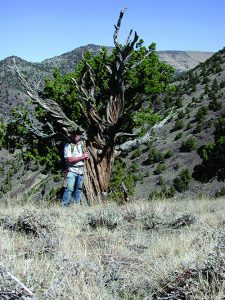
Over time, these vesicles were invaded by percolating mineral-rich water solutions that enter through both visible and microscopic fractures in the host rock. This action is responsible for many of the vesicles becoming filled with various minerals such as zeolites and their associates, as well as micro and macrocrystalline quartz. Microcrystalline quartz is largely present in the form of agate and jasper. Macrocrystalline quartz is also prevalent and has been observed in clear, smoky, and amethystine habits. The amygdales are surface collected after they have weathered out of the numerous basalt flows that are a natural action of seasonal freeze/thaw cycles on the mountain.
My personal collection is divided into five site-specific displays and three interesting variations of amygdaloidal habit. The collection contains approximately 600 amygdale specimens and occupies nearly 80 square feet of display shelves housed in four separate cabinets. Of the specimens currently on display, more than 75 contain prominent pseudomorphs. The process of organizing my collection has allowed me to discover more pseudomorphs and dedicate a portion of the overall display area to their exhibition.
Amygdales Invaded by Pseudomorphs
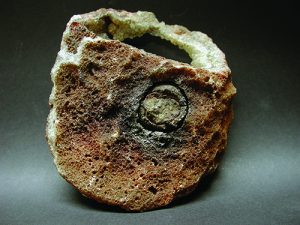
An amygdale containing a pseudomorph makes for a very interesting specimen. The mineralogical oddity of a pseudomorph occurs when the invading mineral solution replaces and takes on the form of a previously existing mineral within the vesicle. To date, pseudomorphs on Hart Mountain are found within a much-localized area less than two square miles in size, within the larger Hart Mountain amygdale occurrence.
To better understand a pseudomorph, it’s helpful to consider the definition. Originating in the mid-19th century, from the Greek “pseudo” for false and “morph” for form, the two words combine to mean false form. American Heritage® Dictionary of the English Language definition of the word is: pseu·do·morph, a noun meaning a false, deceptive, or irregular form, or a mineral that has the crystalline form of another mineral rather than the form normally characteristic of its own composition.
Pseudomorphs from within my study area on Hart Mountain occur exclusively as replacements of zeolite minerals or other minerals commonly associated with zeolites. These pseudomorphs are represented as either complete or partial infillings of agate and jasper into amygdaloidal vesicles whose first occupants were the zeolites and associated minerals such as calcite and pectolite. Most often, a single species replacement occurs, such as with specimens of agate and jasper after scolecite. However, in some instances, the deposition and replacement have occurred across several different species. For example, agate after calcite, after scolecite, after pectolite, is a good example.
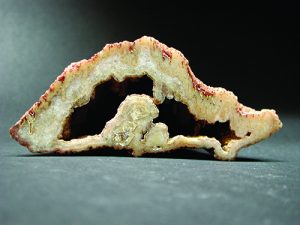
In Cornelius Hurlburt’s book, “Minerals and Man,” Hurlburt states that “Non-zeolite members found almost exclusively in cavities of traprock are: prehenite, datolite, aphophyllite and pectolite. Amethyst, calcite, native copper, native silver, epidote, babingtonite, and chlorite although characteristic of the suite are frequently found in other associations as well.” I find this interesting since the study site of pseudomorph on Hart Mountain contains some of the minerals mentioned in the previous description of zeolites and their associates. Examples include the only area observed to date where amethyst is present; also, a few specimens show a sampling of pectolite; and calcite is abundant and occurs here in a variety of crystal habits. Calcite is present elsewhere on Hart Mountain but it is usually of the massive form and does not generally occur in association with agate. This trait is a notable difference from the other study sites.
Of the pseudomorph specimens, they are quite numerous, accounting for a large percentage of amygdale examples. I suspect most specimens from this area would exhibit some sign of having been in association with another mineral and qualify as a pseudomorph in some way. And, while not definite, I would suspect copper to be responsible for the color of a large amygdale occurrence that is certainly within the boundaries of the pseudomorph study zone. Also of interest are zeolite sprays I have collected from the Sunstone Mining District’s basalts some 20 miles to the northwest. These basalts contain sunstones, whose color and schiller are due to varying amounts of metallic copper. Sunstone is also a variety of feldspar, whose mineral group is distinguished by aluminum, which is also always present in zeolites, and more than any other metal. In short, there are some interesting commonalities between zeolite pseudomorphs in amygdales from the Hart Mountain area and the geology of the Sunstone Mining District.
Defined Display of An Amygdale Collection
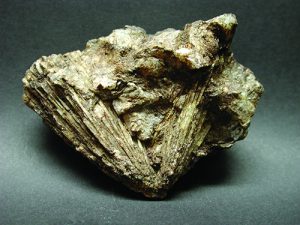
One of my goals in designing my collection has been to accent each piece so that each specimen’s hidden beauty is realized. At the same time, my goal is to leave each piece’s identity as a mineral specimen intact as much as possible. This practice has resulted in a very visually appealing collection and one in which the amygdales can continue to be studied for scientific gain.
Pseudomorphs, I’ve come to realize, may present themselves in ways that are not readily apparent. One specimen that I was photographing for my book, “Hart Mountain Amygdales,” proved to be a good example. I observed a well-defined cross-section of crystal appearing within a partially agate-filled amygdale. The shape seemed vaguely familiar, and after searching the shop, I finally located a large piece of massive calcite from Poker Jim Ridge, which is near Hart Mountain, that contained a calcite crystal that exhibited the same form.
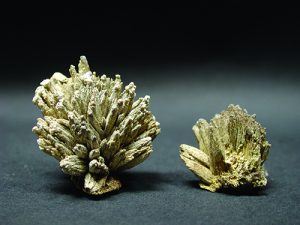
Conversely, the jasper, plume agate, and water level agate found in the interior of another amygdale specimen offered little clue to the crystal faces evident on the specimen’s exterior. While the identity of the pseudo-crystal faces on this specimen is uncertain, I would suspect it to be terminated calcite, with the specimen formed in much the same manner as the rare polyhedral agate from Brazil. Polyhedral agates formed in the negative spaces between calcite crystals and are an uncommon instance of a cast actually being a pseudomorph.
A favorite piece in my collection is one that I thought consisted of only a narrow band of jasper containing a scolecite pseudomorph on a basalt matrix. After studying the piece thoroughly, I realized that in addition to several visible crystal sprays of scolecite on the surface, the piece also had indications of good porcelain jasper running throughout it. The resulting polished specimen revealed several large scolecite sprays cut at an angled cross-section, a few pectolite balls, porcelain jasper, and a few dendrites.
Some specimens exhibited in my collection may not be as showy but still offer interesting clues as to the pseudomorphs’ origin. On one occasion, I came across a freshly cleaved boulder with a large open vesicle revealing large zeolite sprays covered in what appears to be calcite. While the boulder was much too massive to move, I extracted the zeolite sprays relatively intact. Visually, these are the same species of zeolite sprays that I have observed within the Sunstone District’s basalt flows.
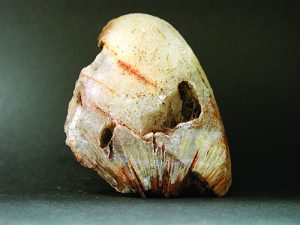
A second such example is a rather plain specimen of pectolite that was later replaced by calcite. While not being especially attractive, the pseudomorph offered good insight into the formation of a second amygdale specimen that also contained a pseudomorph of calcite replacing pectolite. This amygdale specimen then shows evidence of agate infiltration in the form of silica gel, a second infilling of calcite, which then grew until it nearly filled the vesicle, and then druzy quartz as a final stage. Certainly a more attractive specimen than the first, but both specimens are an equally important part of the study.
Another interesting pseudomorph form is when crystal faces are not visible on the exterior of the amygdale but are visible as a perfect cleavage plane of calcite upon scolecite. This cleavage occurs as a break between second-generation calcite replacing a previous zeolite even though both minerals have been replaced by agate.
The process of studying Hart Mountain amygdales has had me guessing many times, and I have also observed some of my assumptions proving false. Still, the activity has been the source of much satisfaction as some discoveries have proved correct after a false start, and my own knowledge has increased. For example, an initial false search to explain why many of the zeolite pseudomorphs appeared to have hollow crystals revealed much about zeolites and their properties.
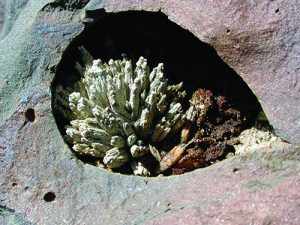
In the process, I learned that zeolites are hydrous silicates with a Mohs hardness of 3.5-5.5. This means that they are also soluble in water and can erode away in addition to being relatively soft. What I had earlier misidentified as a hollow crystal form was the void left after the zeolite core weathered out of its replacement. I also learned that zeolites have the unique property of base or ion exchange. This ion exchange behavior earned them the nickname “molecular sieves” as early as the 1920s.
Today, this capacity in zeolites is widely used in industry for everything from cat litter, water purifiers, oil, and gas refining to serving as a storage medium for captured toxic wastes.
My pursuit of Hart Mountain amygdales has allowed me to combine the aspects of many of my interests into a singular pursuit. The aspects of photography, the earth sciences, and a love for the wild and what is over the next hill have combined lapidary and writing into a unique outlet for my artistic side and has resulted in an amygdale collection that is incredible.
All photos by Steve Ewens.
If you enjoyed what you’ve read here we invite you to consider signing up for the FREE Rock & Gem weekly newsletter. Learn more>>>
In addition, we invite you to consider subscribing to Rock & Gem magazine. The cost for a one-year U.S. subscription (12 issues) is $29.95. Learn more >>>


 Hide i
Hide i












